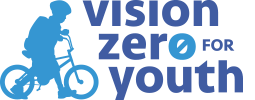New York City Takes Multi-Faceted Approach to Protecting Youth
Winner of the 2019 Vision Zero for Youth Leadership Award! View the press release.
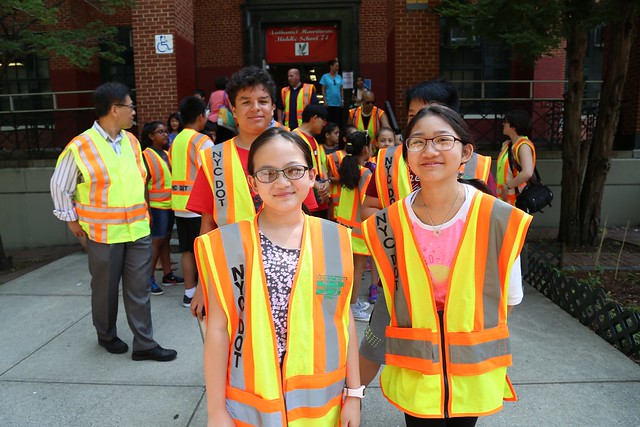
Students from JHS74 helped NYC DOT get started on a Safety Improvement Project outside their school on Oceania St. Photo courtesy NYC DOT
Vision Zero is being adopted around the United States as communities strive to eliminate fatalities and serious injuries on the roads. Vision Zero applies the Safe Systems principles that traffic deaths are preventable, that people are fallible and that multiple strategies requiring the involvement of different disciplines and groups are needed in order to improve the road environment and stop traffic deaths. A key tenet of Vision Zero is the idea that advancing safety of the most vulnerable road users will create a safer environment for all. Vision Zero for Youth shines a spotlight youth road safety, recognizing the unique characteristics of this population within the transportation system.
In 2014, New York City’s Vision Zero Action Plan identified children and seniors as two of its primary vulnerable populations. At the time the Action Plan was released, traffic crashes were the leading cause of injury-related death for children under fourteen years of age. The report also recognized that people walking accounted for the majority of traffic fatalities in the city[i].
New York City’s efforts to protect children demonstrates the concept of Vison Zero for Youth, which emphasizes that an essential component of any program to reduce roadway deaths and injuries is a focus on youth who are walking and biking and who are some of the most vulnerable road users. As communities work to build understanding and political will around Vision Zero, an emphasis on youth safety can encourage public priority for road safety and accelerate uptake of Vision Zero.
In 2019 New York City and the Vision Zero Task Force received the Vision Zero for Youth Leadership Award. This award recognizes cities that are leading the way in prioritizing children’s safety while also improving pedestrian and bicyclist safety for all ages through Vision Zero. New York City’s Vision Zero work has resulted in significant safety improvements that have benefitted youth throughout the city. The city uses roadway design improvements and safety cameras in school zones to reduce speeds and make crossings safer for its residents and visitors. It also engages youth to serve as their own advocates for safe streets. These strategies have required the engagement and ongoing communication and coordination of several agencies. This case study focuses on some of the design, enforcement and engagement strategies that have benefited youth so that other cities might consider how they can tailor these strategies to improve safety for their youth.
Changes to roadway design and operations near schools
Speed management and traffic calming through road design are at the heart of achieving the goal of reaching zero fatalities and serious injuries on the roads. Reducing the velocity of traffic crashes decreases injury severity, especially for the most vulnerable road users. New York City applies these goals on the streets around schools using infrastructure design, enforcement, and speed limits.
As a vulnerable population, youth are an important component of Vision Zero in New York, and the streets around schools are established locations for safety treatments. While the NYC Department of Transportation (NYC DOT) School Safety unit operates with a clear focus on the environments near schools, the unit is shifting away from the assumption that children heading to school will travel exclusively on distinct paths to and from school. The School Safety staff understand that young people are one of many road users who will use the transportation system in New York City as a whole, thus they are working to make every route a safe route and rethinking the idea of the ‘school zone’. Will Sherman, Deputy Director of School Safety pointed out that “Kids shouldn’t have to memorize which side of the intersection is best to cross…and they are not always going home – they are going to the library; they’re going to the park – kids are everywhere. Let’s just make all the places as safe as possible, not give them a map.” The team is also making an effort to further the impact and effectiveness of their efforts, while identifying and reducing ineffective measures which consume resources for little return.
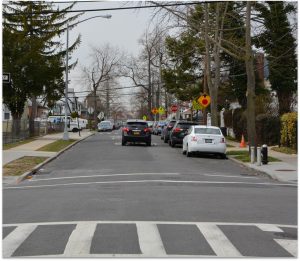
An example of oversignage. Photo courtesy NYC DOT
In prior years, School Safety work focused heavily on adding school signage and “school” pavement markings near schools and managing the implementation of capital projects and slow zones. However, a NYC DOT study on the efficacy on the signage and markings revealed that the signs and school word markings had no measurable impact on safety. School signs got lost in the abundance of signs present on the streets and had no impact on driver behavior. The School Safety unit undertook a signage reduction program, essentially ‘right-sizing’ their use, to increase the effect and impact of each sign. Instead of fifteen or more signs leading to each school, there are now only two or three, which are in immediate proximity to the school. In addition, the sign, which previously said “ahead”, now says “school”
With signage reduction underway, the School Safety unit was able turn its attention to more essential infrastructure improvement projects such as Third Avenue in the Bronx, and Oceania Street in Queens, among others. These are more substantial street redesign projects, which measurably improve safety where youth commonly travel. By bringing these formerly outsourced projects back in-house, the School Safety team can implement medium- and longer-term changes more quickly and efficiently. Nina Haiman, Director of the School Safety Unit, articulated the shift as a “redirection to higher impact projects.” Haiman emphasized that the most significant traffic safety problems that students encounter are often not on streets immediately adjacent to their schools but rather on higher traffic corridors on the way to and from school, and her goals are to prioritize those locations.
Third Avenue Project
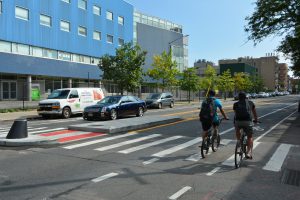
Third Ave and E. 172nd St (after). Photo courtesy NYC DOT.
Third Avenue in the Bronx was a Vision Zero Priority Corridor and a Priority Area, which are areas and corridors identified through data analysis as having disproportionate concentrations of crashes. Third Avenue is a wide, busy thoroughfare, with high motor vehicle traffic and many trucks and other large commercial vehicles. More than 40 schools are in a five-minute walk of Third Avenue, between East Tremont Avenue and East 161st St. The project included a major street redesign, changes to the parking regulations and intersection improvements. Myriad safety concerns were identified at the corridor level and at intersections along the road. Traffic calming treatments included a 4 lane to 3 lane right sizing, curb extensions, left turn traffic calming (such as a hardened center line, a treatment which tightens up and slows left turns), and pedestrian islands. In the first year after project implementation total crashes were reduced by 18 percent[ii].
Oceania Street Project
Oceania Street in Bayside, Queens was also targeted for school safety improvements. The corridor is heavily used by students accessing MS 74. The street includes access to Interstate 495/Horace Harding Expressway. Several bus routes were located on the corridor, and motor vehicle traffic travel speeds were higher than the 25-mph speed limit almost ninety percent of the time. In addition to student/school traffic, the street was heavily traveled by bicyclists, partly due to proximity to a favorite mountain biking park. With its unmarked twenty-five-foot shared parking and travel lanes, the road design encouraged erratic behavior by drivers, including double parking and illegal U-turns. Additionally, the intersection of Oceana Street and 210th Street consisted of a wide, unsafe merge between southbound and northbound traffic.
Safety treatments for the corridor consisted of a two-way protected bike lane along the park, which offers cyclists a much safer space, but also serves the dual purpose of reducing lane width, thereby slowing traffic. Leading pedestrian intervals were installed on the service roads leading to the expressway, allowing pedestrians to get a head start crossing a street before traffic proceeds. Parking regulations along the corridor were overhauled, extending the ‘no-standing’ zone during school drop off and pick up hours, and removing several spaces which had reduced visibility OR which resulted in improved visibility. Slow zones were added, as well as stop controlled high visibility crosswalks. The merge of the two streets was also improved[iii].
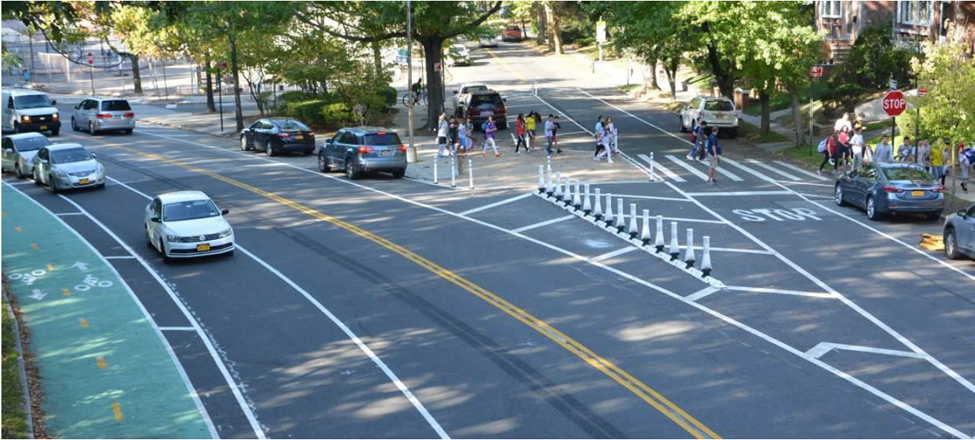
210 Street at Oceana Street, Queens. Bike lane, painted curb extension, and new stop-controlled crosswalk by J.H.S.74 Nathaniel Hawthorne. Photo courtesy NYC DOT.
210 Street at Oceana Street, Queens. Bike lane, painted curb extension, and new stop-controlled crosswalk by J.H.S.74 Nathaniel Hawthorne. Photo courtesy NYC DOT.
Overall, the improvements added designated, marked, safer spaces for all users around the school. Driver speeds were slowed, better behavior was encouraged via infrastructure cues and driver visibility problems and conflicts were eliminated. Total crashes declined by 32 percent in the first year after the project was implemented.
Safety Camera Program
One of New York City’s most notable strategies for speed management is use of automated enforcement. In 2014, NYC DOT installed speed safety cameras in 140 designated locations around the city, exclusively in school zones. Research showed that automated enforcement considerably reduced speeding, and resultant injuries from traffic crashes, in other cities in the United States and internationally. In a review of the first two years of data, NYC DOT found an almost 8% reduction in overall crashes, and a 15% reduction in injury crashes in locations with safety cameras. Total number of people injured in crashes in these locations were reduced by just over fourteen percent. The greatest reduction was in injuries to pedestrians, which was just over twenty-three percent. Remarkably, the number of average daily violations at safety camera locations continued to drop, with an overall decline of about 60% between the inception of the program and December 2016. Repeat offenders were also very low; with only nineteen percent of those who received a speed camera violation receiving a second violation[iv] .
In 2019, New York City was allowed to expand the safety camera program. The changes permitted camera placement within one quarter mile of schools, allowing the city to place them on some of the busier arterials which are often more dangerous than the streets on which schools are located. The number of allowed cameras has grown to 750, with expanded hours that permit operation from 6 am – 10 pm.
Education and Outreach
New York City employs comprehensive public engagement efforts under Vision Zero. Messaging to young people works hand in hand with the comprehensive communication strategies the agency employs throughout the city.
The core mission of the Safety Education and Outreach program is to serve New York City Schools, “reaching out to students from Kindergarten to 12th grade and to parents with innovative information programs.” Kim Wiley-Schwartz, Assistant Commissioner for Education and Outreach at NYC DOT, and her team visit close to six hundred schools per year to engage directly with students and their parents and families. NYC DOT strives to grow knowledge and capacity around the transportation system itself and activate the city’s youth to work towards a better transportation environment for themselves.
The Education and Outreach team uses experiential learning strategies such as student-envisioned roadway redesigns and students taking measurements of speed and other data, thus equipping students with knowledge about the ingredients for safer street environments and how to engage in civic processes to request changes.

Students from JHS74 helped NYC DOT get started on a Safety Improvement Project outside their school on Oceania St. Photo Courtesy NYC DOT.
Wiley-Schwartz said, “Having kids observe and perform a basic assessment around drop off and pickup, looking at matters like speed, failure to yield, pedestrian and bicycle infrastructure, is a great touchpoint for NYC DOT’s outreach team”, according to Wiley-Schwartz. “By focusing on their own safety, we can leverage that to teach them that they can ask for safer streets,” said Wiley-Schwartz. Kids can learn what tools are in the toolbox for safer streets and be their own best advocates.
The Vision Zero Youth Council – a student group founded by Alison de Beaufort, who lost three classmates in traffic crashes – serves as an example of youth empowerment. Supported by M.S. 51, NYC DOT and Transportation Alternatives, the Council provides a platform for youth, from fourth grade to twelfth, to raise awareness and advocate for safer streets.
Through the Outreach and Education program, NYC DOT has worked to make youth voices heard around traffic safety promotion. Kids work with NYC DOT to make photo simulations, street safety posters and videos, art projects around improving the built environment.
Collaboration is fundamental
Authentic and frequent interagency collaboration forms the foundation of NYC’s Vision Zero work, which has meant building relationships beyond the transportation sector and engaging a broad base of partners around the cause of Vision Zero and improving road safety for all users.
Agencies involved in New York City’s Vision Zero Task Force include City Hall, New York City Police Department, NYC DOT, Taxi and Limousine Commission, Department of Citywide Administrative Services, Department of Health and Mental Hygiene, the New York City Department of Education and others.
Kim Wiley-Schwartz credits the Vision Zero Task Force with not only more powerful public communication that occurs with the support and collaboration of several key government agencies, but also better institutional understanding between agency partners.
Vision Zero is far from just a municipally supported effort. Advocates play an important role in demanding safety. Transportation Alternatives and Families for Safe Streets (FSS) have been integral to the success of Vision Zero and the youth focus, as a partner who works outside of the city organization. The advocacy voice is a powerful ally to both the community and to NYC DOT’s safety efforts. Having been formed by families who have lost loved ones to traffic violence, FSS have been able to mount extremely compelling true-life storytelling campaigns, which focus on the impacts of traffic crashes on families. The organization was instrumental in helping NYC DOT successfully lobby for a citywide reduction in the speed limit to twenty-five mph in 2014. The establishment, continuation and growth of the safety camera program has been supported by the advocacy of Families for Safe Streets.
Staying vigilant moving forward
What NYC has been able to accomplish is impressive and there has been a significant decrease in roadway deaths and injuries since the Vison Zero program began. Yet NYC officials are quick to caution about the importance of being vigilant. In early 2019 New York City began to see an uptick in fatalities and were ready to understand and address the problems. By looking at data and identifying the root causes of the more recent crashes, agencies have set about using every tool they have to solve for crashes. This includes: educating and enforcing against aggressive left turns, moving on-street outreach to nine high crash corridors with high visibility enforcement following this work, focus on drivers under 25 and implementing robust street design. In July 2019, the City was able to operate their existing speed cameras from school hours to 6am – 10pm every weekday throughout the year. This created an opportunity to do large-scale outreach to all drivers in New York through a series of press events and paid media.
Conclusion
New York City is an exceptional example of Vision Zero and Safe Systems at work and what a focus on youth can contribute to reaching the goal of eliminating roadway deaths. Under Vision Zero, New York City is concentrating investments in safe infrastructure, education and outreach while using a collaborative, multi-group process to attack road safety from several entry points. With a focus on safety improvements around locations where youth travel more frequently, a city can incrementally introduce programs such as automated enforcement and innovative infrastructure improvements which could face political resistance if implemented more broadly at the outset.
While New York City is unique in many ways, the components of this Vision Zero approach can exist in any size city or community. Key ingredients include a commitment at the top, a broad coalition within local government and a strong advocacy voice. The multi-faceted approach includes redesigning streets and educating all users while tackling the very important issue of speed. The school zone can be a natural starting place for gaining public buy-in around slower speeds and infrastructure improvements.
_________________________________________________________
[i] Mayor Bill de Blasio, New York City. 2014. Vision Zero Action Plan. New York, NY: NYC DOT. Retrieved from http://www.nyc.gov/html/visionzero/pdf/nyc-vision-zero-action-plan.pdf
[ii] NYC DOT School Safety . 2017. Third Avenue. School Safety Improvements. Presented to Bronx Community Board 6, June 16. Retrieved from https://www1.nyc.gov/html/dot/downloads/pdf/third-ave-bronx-cb3-may2017.pdf.
[iii] NYC DOT School Safety. 2017. Oceania St – 201 St. Horace Harding Expy to Brooklyn Queens Greenway. School Safety Improvements. Presented to Queens Community Board Transportation Committee 11, February 27.
[iv] New York Department of Transportation. 2016. Automated Speed Enforcement Program Report . New York City, NY : NYC DOT. Retrieved from http://www.nyc.gov/html/dot/downloads/pdf/speed-camera-report-june2017.pdf
